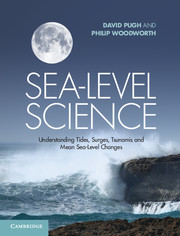Book contents
- Frontmatter
- Contents
- Preface
- List of acronyms
- List of main symbols
- Chapter 1 Introduction
- Chapter 2 Sea-level measuring systems
- Chapter 3 Tidal forces
- Chapter 4 Tidal analysis and prediction
- Chapter 5 Tidal dynamics
- Chapter 6 Shallow-water and coastal tides
- Chapter 7 Storm surges, meteotsunamis and other meteorological effects on sea level
- Chapter 8 Tsunamis
- Chapter 9 Spatial variations in sea level
- Chapter 10 Mean sea-level changes in time
- Chapter 11 Sea-level changes in time to do with the solid Earth
- Chapter 12 Sea-level applications
- Chapter 13 Sea level and life
- Appendix A Basic hydrostatic and hydrodynamic equations
- Appendix B Currents
- Appendix C High and low water times and heights from harmonic constituents
- Appendix D Theoretical tidal dynamics
- Appendix E Legal definitions in the coastal zone
- Glossary
- Index
- References
Chapter 12 - Sea-level applications
Published online by Cambridge University Press: 05 May 2014
- Frontmatter
- Contents
- Preface
- List of acronyms
- List of main symbols
- Chapter 1 Introduction
- Chapter 2 Sea-level measuring systems
- Chapter 3 Tidal forces
- Chapter 4 Tidal analysis and prediction
- Chapter 5 Tidal dynamics
- Chapter 6 Shallow-water and coastal tides
- Chapter 7 Storm surges, meteotsunamis and other meteorological effects on sea level
- Chapter 8 Tsunamis
- Chapter 9 Spatial variations in sea level
- Chapter 10 Mean sea-level changes in time
- Chapter 11 Sea-level changes in time to do with the solid Earth
- Chapter 12 Sea-level applications
- Chapter 13 Sea level and life
- Appendix A Basic hydrostatic and hydrodynamic equations
- Appendix B Currents
- Appendix C High and low water times and heights from harmonic constituents
- Appendix D Theoretical tidal dynamics
- Appendix E Legal definitions in the coastal zone
- Glossary
- Index
- References
Summary
. . . we cannot tell
When any given tide on the heart’s shore
Comes to the full.
. . . Few could endure
That knowledge, and not die.
It is better to be unsure.
Jan Struther, High Tide
The application of sea-level and tidal knowledge to the design and construction of useful marine structures and systems includes:
harbour design and operation,
design of coastal defences to resist flooding,
coastal sediment control, groynes,
flood warning systems,
estuary, wetland, lagoon and inlet management,
offshore structures for gas and oil extraction,
schemes for generating power,
cooling water intakes, effluent discharges to the sea,
climate change forecasts and planning.
Tides offer many invaluable on-going environmental services that are not costed or charged. Ship routing between ports has used tides since historical times. Most of the great ports of the world are situated near the mouths of large rivers and many are a considerable distance inland. London, on the River Thames, and Hamburg, on the River Elbe, are good examples of inland ports. By travelling inward on a flooding tide and outward on an ebbing tide, ships can make considerable savings of fuel and time. The vigorous tidal currents serve to keep channels deep. The tidal flows can also prevent harbours freezing during winter, for example in New York, both by their mixing action and by the introduction of salt water which lowers the freezing point. Pollution, inevitably associated with large industrial developments and centres of population, is also more readily diluted and discharged to sea where there are regular exchanges of tidal water. The conditions for ports where tidal ranges are relatively large may be contrasted favourably with those, for example Marseilles, where tides are small. The pollution problems are much greater in the Mediterranean, and despite their high rates of fresh-water discharge, neither the Rhône nor the Nile have proved navigable for any but the smallest sea-going vessels.
When planning marine engineering works, the design parameters include not only sea-level changes: tides, surges, tsunamis and mean sea level (MSL), but also waves, winds, earthquakes, sediment movement, marine fouling and ice movement. Here we focus only on the sea-level aspects of the design engineer’s considerations.
- Type
- Chapter
- Information
- Sea-Level ScienceUnderstanding Tides, Surges, Tsunamis and Mean Sea-Level Changes, pp. 318 - 344Publisher: Cambridge University PressPrint publication year: 2014



